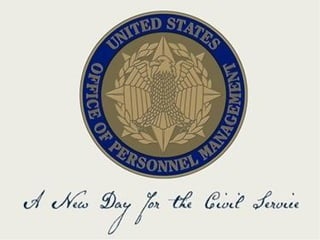
Federal employee compensation and performance presentation
- 2. Musings on Federal Employee Compensation and Performance By Caroline Krewson
- 3. • The Office of Personnel Management released the 2012 Federal Employee Viewpoint Survey Results in November 2012. The results show the opinions of 687,000 Federal employees.
- 4. • I found notable the downward trend in the percentage of positive responses to two statements: “Promotions in my work unit are based on merit” and “In my work unit, differences in performance are recognized in a meaningful way.”
- 5. • The first statement resulted in a 33.5% positive response. The second statement resulted in a 33.8% positive response. Indeed, the percentage of positive responses to these statements has remained below 40% since 2008, the earliest year used for comparison in the 2012 report.
- 6. • These results are not surprising to me, based on my many years of experience working in the Federal government. I can think of two reasons. The first is the increase in the use of career ladder promotions.
- 7. • These are promotions an employee can obtain noncompetitively after one year provided his/her rating of record is level 3 or fully successful. For example, an employee may be hired at grade 7 (the General Schedule has grades 1-15) in a position with promotion potential to grade 11. After one year at the grade 7 level, the employee may be promoted to grade 9, and after another year, the employee may be promoted to grade 11. In less than 3 years, an employee may go from making $42,209 as a grade 7 (with locality pay) in Washington, DC, to $64,548 as a grade 11.
- 8. • Second, there are the automatic step increases within the grade. Continuing with the example above, after a full year at grade 11, the employee earns a within grade increase from one step to the next step (there are 10 steps in a grade) for another $2000 pay increase.
- 9. • The step increases come every year for the first three steps, every two years for the next three, and every three years for the last three before step 10. This happens regardless of the type or level of work or whether the person is outstanding in his/her performance (level 5), or exceeds fully successful (level 4), or fully successful (level 3).
- 10. • In sum, an employee who works as a GS-14 supervisory information technology specialist with an outstanding or exceeds rating is treated the same as the GS-07 fully successful human resources specialist when it comes to step increases, and possibly worse when it comes to promotions if the GS- 14 is not in a career ladder but the GS-07 is, since those in career ladders are often promoted (noncompetitively) with a level 3 rating after a year, while those who are merely level 3, or even level 4, are unlikely to be selected competitively for a promotion, and usually not on a timetable such as that provided for career ladder promotions since they have to wait for a different position at the higher level to come open.
- 11. • Level 3 may do as an acceptable level of competence for an employee to remain employed for 30 years and earn a retirement (they cannot be unacceptable or poor), but not for earning a promotion and step increase. Given the amount of the pay increases from promotions and step increases, and how often they occur, it would serve the morale of the better performing employees to see the minimum level raised to level 4. It would certainly provide the taxpayer better value for his/her money.
- 12. •About the Author: Possessing more than 25 years of executive experience in the Federal government and private industry, Caroline Krewson retired with the rank of Air Force Reserve Colonel. Ms. Krewson also earned a Masters of Public Administration from Golden Gate University, graduating at the top of her class with the distinction of summa cum laude.
- 13. The nation’s highest civil service awards — the Presidential Ranks of Distinguished Executive and Distinguished Professional